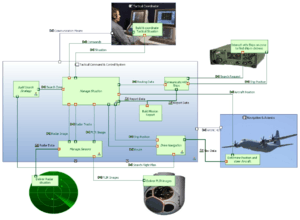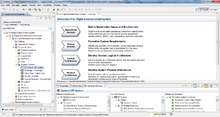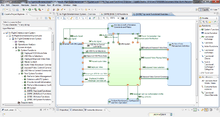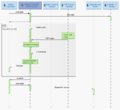Capella (engineering)
Capella is an open-source solution for model-based systems engineering (MBSE). Hosted at polarsys.org, this solution provides a process and tooling for graphical modeling of systems, hardware or software architectures, in accordance with the principles and recommendations defined by the Arcadia method. Capella is an initiative of PolarSys, one of several Eclipse Foundation working groups.
 80% | |
 | |
| Developer(s) | PolarSys[1] Industry Working Group of the Eclipse Foundation |
|---|---|
| Stable release | 1.4.1[2]
|
| Repository | |
| Written in | Java |
| Platform | Linux, Mac OS X, Microsoft Windows |
| Type | Model Driven Architecture |
| License | Eclipse Public License |
| Website | http://www.polarsys.org/capella |
Usage
Capella is mainly used for modeling complex and safety-critical systems in embedded systems development for industries such as aerospace, avionics, transportation, space, communications and security and automotive.
History
Capella was created by Thales in 2007, and has been under continuous development and evolution since then. The objective is to contribute to the transformation of engineering, providing an engineering environment which approach is based on models rather than focused on documents, piloted by a process, and offering, by construction, ways to ensure effective co-engineering. Operational experts from engineering then defined a unified language for modeling architectures in the group and specified the associated tooling, Capella.
Capella provides ergonomics that are similar to PowerPoint / Visio and Excel tools. Hence, the resulting environment is actually intuitive and allows engineers to focus on defining their architectures instead of learning and operating complex generic modeling languages, such as UML or SysML, to capture their design requirements. Because it is based on the Arcadia method, it also guides engineers in their activities, which generic modeling tools in general, do not do. In 2015, Capella was released as an Eclipse open source project by PolarSys, a Working Group[3] of the Eclipse Foundation through the French collaborative project Clarity,[4] supported by the Banque Publique d’Investissement (Bpifrance[5]). Capella has its own life cycle. A major release, providing new functionality is delivered each year end while several versions called minor, including bugs fixes, are generally delivered over the course of the year.
Principles
Capella comes with its own metamodel, which defines the language concepts the user can enable in a Capella project. The user creates an instance of this metamodel and can then view the model from various perspectives through diagrams, according to his/her concerns. The user can also, via the palette associated with diagrams, create new model elements. A Capella project consists of a model part ("melodymodeller") and a graphic part ("aird").


When a Capella project is created, the workbench interface is presented to the user. It contains various areas:
- The "methodological browser" area, shows the user the various engineering phases for architecture modeling and shortcuts to create new diagrams within the given engineering phase; this view also facilitates the "transition" between engineering phases, so as to create links between phases and associated elements;
- The "semantic browser" area provides tools for navigating into the model: for each selected item in the "project" area or on a diagram, the semantic browser area will present the user all references for that element, that is, its capacity or reference relationships and all diagrams in which the element is involved;
- The "project" area is a more traditional view; it is a tree view of the Capella model, and contains all the semantic elements and diagrams created by the user;
- The "diagram" area presents a graphical view of an extract of the model and allows the user to edit the model. The user can create, modify or delete elements and can also change the organization or appearance of elements in the diagram;
- The "properties" area displays all the properties of a selected element in the model or in a diagram.
Diagrams
Through Capella, the user can handle several types of diagrams. The representation of elements in diagrams is governed by a color code specific to each type of analysis. Some examples of diagrams:
- Operational Capabilities
 Operational Architecture
Operational Architecture Logical Architecture
Logical Architecture Physical Architecture
Physical Architecture Functional Scenario
Functional Scenario Class Diagram
Class Diagram
Extensibility
The workbench can be enhanced or specialized for a given business need, according to the concept of "Point of View", defined by the standard ISO/IEC 42010.[6] These extensions provide, for example:
- The ability to manage new information specific to a particular engineering need with its associated tooling. For example, non-functional properties such as time constraints for performance analysis, or constraints related to safety or security, cost of component for cost analysis, mass, etc. ;
- The ability to specify the engineering approach with various architectural styles;
- The ability to add new features to the workbench, such as a documentation export or a specialization of the transition system / subsystem mechanism.
Compatibility
Capella is supported on environments based on Java 7 and higher on the following platforms:
- GNU / Linux
- Mac OS X
- Windows XP, Windows Vista, Windows 7
Dependencies
The latest version of Capella is based on:
Community and communication
Links to the community and more information are available on the PolarSys website. Capella documentation is available for download from the website.[9]
Capella was presented at several events:
| Conference | Title | Date | Place |
|---|---|---|---|
| SiriusCon 2016 | Collaborative modeling with Capella and Sirius[10] | 15/11/2016 | Paris |
| Incose 2016 | Simplifying (and enriching) SysML to perform functional analysis and model instances[11] | 18/06/2016 | Edinburgh |
| EclipseCon France | Hands-On Systems Modeling with ARCADIA / Capella[12] | 07/06/2016 | Toulouse |
| Dutch Eclipse Day | Model-based engineering with Capella: Status and perspectives[13] | 18/04/2016 | Eindhoven |
| EclipseCon North America | Mars exploration guided by PolarSys[14] | 07/03/2016 | Reston |
| ERTS | MBSE with ARCADIA Method and Capella Tool[15] | 27/01/2016 | Toulouse |
| MODELS | CLARITY: Open-Sourcing the Model-Based Systems Engineering Solution Capella[16] | 29/09/2015 | Ottawa |
| SPLC | Tooling Support for Variability and Architectural Patterns in Systems Engineering | 23/07/2015 | Nashville |
| MODELS | CLARITY: Open-Sourcing the Model-Based Systems Engineering Solution Capella[17] | 29/09/2015 | Ottawa |
| INCOSE International Symposium | Implementing the MBSE Cultural Change: Organization, Coaching and Lessons Learned[18] | 14/07/2015 | Seattle |
| INCOSE International Symposium | From initial investigations up to large-scale rollout of an MBSE method and its supporting workbench: the Thales experience[19] | 14/07/2015 | Seattle |
| EclipseCon France | Capella time-lapse: A system architecture model in 30 minutes[20] | 25/06/2015 | Toulouse |
| EclipseCon France | Systems Modeling with the ARCADIA method and the Capella tool[21] | 24/06/2015 | Toulouse |
| Nouvelle France Industrielle | Presentation of Clarity and Capella to Emmanuel Macron[22] | 18/05/2015 | École des Mines of Nantes |
| EclipseCon North America | Capella time-lapse: A system architecture model in 30 minutes[23] | 12/03/2015 | San Francisco |
| EclipseCon Europe | Capella on the field: Model-based system engineering use cases[24] | 29/10/2014 | Ludwigsburg |
| Model-Based System Engineering (MBSE) Symposium | The Challenges of Deploying MBSE Solutions[25] | 28/10/2014 | Canberra |
| Model-Based System Engineering (MBSE) Symposium | Arcadia and Capella in the Field[26] | 27/10/2014 | Canberra |
| EclipseCon France | Arcadia / Capella, a field-proven modeling solution for system and software architecture engineering[27] | 19/06/2014 | Toulouse |
| EclipseCon North America | Arcadia / Capella, a field-proven modeling solution for system and software architecture engineering[28] | 20/03/2015 | San Francisco |
| Complex Systems Design & Management (CSDM) | Model-Based Collaboration for System, Software and Hardware Engineering[29] | 04/12/2013 | Paris |
See also
References
- "PolarSys website". Retrieved 2017-01-12.
- "Capella 1.4.1 (latest stable release)". Retrieved 2020-07-01.
- "PolarSys Proposal for Capella". Retrieved 2015-10-23.
- "Ecosystem for the Model Based Systems Engineering Solution Capella". Retrieved 2015-10-23.
- "Bpifrance website". Retrieved 2015-10-23.
- "ISO / IEC / IEEE 42010: 2011, Systems and software engineering - Architecture description". Retrieved 2015-10-23.
- "Kitalpha: an environment to develop and execute MBE". Retrieved 2017-01-12.
- "EMF Diff / Merge: a diff / merge component for models". Retrieved 2017-01-12.
- "Capella Documentation". Retrieved 2015-10-23.
- "Collaborative modeling with Capella and Sirius". Retrieved 2016-11-15.
- "Simplifying (and enriching) SysML to perform functional analysis and model instances". Archived from the original on 2016-10-09. Retrieved 2016-10-06.
- "Hands-On Systems Modeling with ARCADIA / Capella". Archived from the original on 2016-10-09. Retrieved 2016-10-06.
- "Model-based engineering with Capella: Status and perspectives". Archived from the original on 2016-10-09. Retrieved 2016-10-06.
- "Mars exploration guided by PolarSys". Archived from the original on 2016-10-09. Retrieved 2016-10-06.
- "MBSE with ARCADIA Method and Capella Tool". Retrieved 2016-10-06.
- "=CLARITY: Open-Sourcing the Model-Based Systems Engineering Solution Capella" (PDF). Archived from the original (PDF) on 2016-02-15. Retrieved 2016-10-06.
- "CLARITY: Open-Sourcing the Model-Based Systems Engineering Solution Capella" (PDF). Archived from the original (PDF) on 2016-02-15. Retrieved 2015-10-23.
- "Implementing the MBSE Cultural Change: Organization, Coaching and Lessons Learned". Archived from the original on 2016-03-03. Retrieved 2015-10-23.
- "From initial investigations up to large-scale rollout of an MBSE method and its supporting workbench: the Thales experience". Archived from the original on 2016-03-03. Retrieved 2015-10-23.
- "Capella time-lapse: A system architecture model in 30 minutes". Archived from the original on 2015-09-11. Retrieved 2015-10-23.
- "Systems Modeling with the ARCADIA method and the Capella tool". Archived from the original on 2015-09-14. Retrieved 2015-10-23.
- "Obeo et Thales rencontrent le ministre de l'Economie lors du lancement du projet Industrie du futur". Retrieved 2015-10-23.
- "Capella time-lapse: A system architecture model in 30 minutes". Archived from the original on 2015-10-21. Retrieved 2015-10-23.
- "Capella on the field: Model-based system engineering use cases" (PDF). Retrieved 2015-10-23.
- "The Challenges of Deploying MBSE Solutions". Archived from the original on 2016-02-28. Retrieved 2015-10-23.
- "Arcadia and Capella in the Field". Archived from the original on 2016-02-28. Retrieved 2015-10-23.
- "Arcadia / Capella, a field-proven modeling solution for system and software architecture engineering". Archived from the original on 2015-10-21. Retrieved 2015-10-23.
- "Arcadia / Capella, a field-proven modeling solution for system and software architecture engineering". Archived from the original on 2016-03-03. Retrieved 2015-10-23.
- "Model-Based Collaboration for System, Software and Hardware Engineering". Retrieved 2015-10-23.